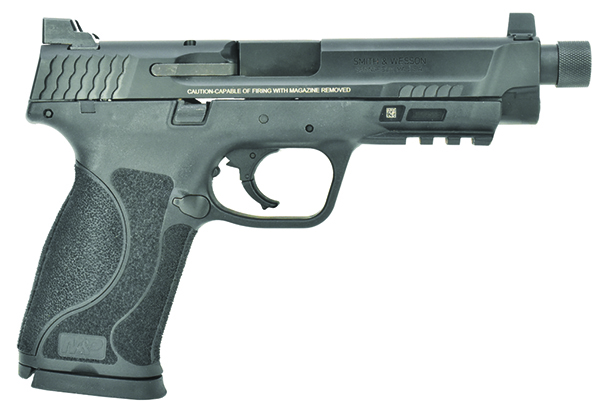GUN TESTS GRADE: A-
$523
One of our testers has a Smith & Wesson Model 559 in his safe. That pistol is a second-generation version of the S&W Model 59, itself a descendant of the S&W Model 39. It was the result of the U.S. Military’s pistol tests in the 1950s. The U.S. Ordnance Department had been impressed by the German P38 Walther and wanted a similar design, so S&W entered the Model 39, which was the first commercially viable double-action pistol designed by an American manufacturer. Smith’s first 9mm was good enough to have been adopted by the SEALs for a while.
| Action Type | Semi-auto, striker fired |
| Overall Length | 8.4 in. |
| Overall Height | 5.5 in. |
| Maximum Width | 1.31 in. |
| Weight Unloaded | 1.7 lbs. |
| Weight Loaded | 2.4 lbs. w/11 rounds 230-gr. |
| Slide Material | Stainless steel |
| Slide Retraction Effort | 16.6 lbs. |
| Receiver Material | Polymer |
| Finish | Armornite |
| Front Strap Height | 2.75 in. |
| Back Strap Height | 4.0 in. |
| Barrel Length | 5.1 in. |
| Grip Thickness (Maximum) | 1.22 in. |
| Grip Circumference | 5.75 in. w/small insert |
| Magazine | Two 10-round |
| Rear Sight | 2 dots in dovetail |
| Front Sight | Single dot in dovetail |
| Sight Radius | 6.9 in. |
| Trigger Pull Weight | 5.6 lbs. |
| Trigger Span | 2.9 in. |
| Safety | Trigger, striker block |
| Warranty | Limited lifetime, lifetime service |
| Telephone | (800) 331-0852 |
| Website | Smith-Wesson.com |
| Made In | USA – Massachusetts |
The Browning Hi-Power had been on the market since 1935 as a high-capacity 9mm semi-auto. It, however, was a single-action with what was normally a decent trigger, and that scared too many people in management, so the call went out for a modern DA/SA pistol. Because more bullets are, normally, a very good thing, Smith & Wesson started working on higher-capacity handguns using the action of the proven Model 39. The Model 59 was introduced in 1971 to big fanfare and big success.
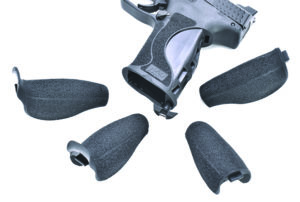
Then, a little company from Austria introduced high-capacity double-action pistols using polymer frames and set the shooting world on its ear. Smith & Wesson followed suit with the Sigma models, which were a bit too much like the Glock, and court filings ensued.
Smith & Wesson went back to the drawing board, introducing a new high-capacity polymer pistol in 2005. Completely re-engineered and using a time-honored name, the M&P (Military & Police) soon began making major inroads into the law enforcement market. One of today’s major successes with police and commercial customers alike, we added one of their more recent M&P variants to our lineup.

Our sample is one of their M2.0s, meaning 2nd generation (at least). The first generation itself was good, with several of our group having used them well in USPSA Production Division for a while. The Gen 2 moniker usually means that things have been tweaked from the first gen, and the M&P here is no exception. Not to insinuate that the first model was not a very serviceable piece, because indeed it was, but there were things we wanted improved a bit. First were the grips. Every grip panel extant is a compromise between comfort and control. We tend to err on the side of control and preferred a bit more texture. As with many early polymer pistols, we thought the S&W M&P’s grips were too smooth. Entire cottage industries sprung up to stipple those frames and to help owners hold onto them in adverse conditions. The M2.0 takes care of that problem — these will not slip in your hand. The texture on these grips is aggressive, maybe even almost to the point of being too coarse. That was not a concern to us because it is much easier to carefully, gently, tenderly sand those points down than it is to make them sharper. The trigger on the first gen pistol was good, but these are better. The M2.0’s have less overtravel, a more positive-feeling break, and an audible reset as the trigger rebounds.
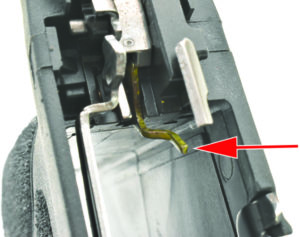
The slide and the frame on the M2.0 maintained basically the profile as the Gen 1 and we thought that was fine — Smith & Wesson engineers had already done a very good job of creating a pistol with a very low bore axis that would sit down in the hand and help reduce felt recoil. The muzzle end of the slide on the M&P has been dramatically chamfered, making reinsertion into a holster a pretty simple thing to do. A series of wave-shaped curves at the rear end of the slide do a great job as cocking serrations, while there is a minimalist set of cuts on the front of the slide to help with press checks. There is a small viewport cut into the rear of the barrel hood to allow the shooter to do a visual check for chamber status.
The M&P employs an external extractor. The trigger is a two-piece, hinged affair that must be depressed properly before trigger compression can be completed. This Tactical model comes with a three-dot sight set, mounted in dovetails to allow them to be adjusted for windage and of a sufficient height to allow them to still be visible while using most suppressors.
The frame has interchangeable palm swells to allow the pistol to be custom fitted to the shooter’s hands. Small, medium, medium/large, and large inserts are included. We suggest that you decide on which to use based not on how it feels in your hand but whether your finger fits on the trigger correctly. The inserts are changed out by rotating a pin at the bottom rear of the magazine well. Move it either direction 90 degrees and pull straight down. The pin base itself can be used as base for a lanyard loop, if desired.
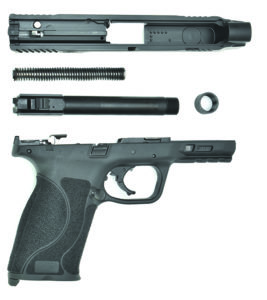
Once again, this is an ambidextrous firearm. Slide-stop levers can be accessed from both sides of the frame, and we can see a modification there as well. Our old M&Ps would frequently see the slide bounce off the slide stop when the magazines were inserted with enthusiasm, as we are prone to do. That isn’t any real problem if expected. On the current pistol, we see a new part immediately forward of the left-side slide stop that appears to prevent that. Repeated attempts with our sample, using dummy and live ammo, did not incite the slide to drop until we specifically made it do so. The magazine catch is also easily reversed.
The pistol is supplied with two 10-round magazines. Each of those have large base pads that could be easily grabbed with the help of the scallops cut into the base of the grip frame, in the event of a magazine needing to be manually stripped out of the pistol.
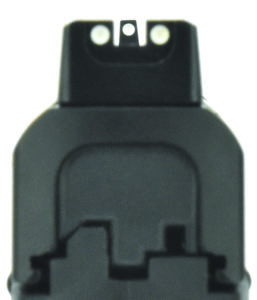
Field-stripping this pistol is easy and unique. Remove the magazine, manually and visually check to make sure the chamber is empty. Do it again. Lock the slide to the rear. Look into the magazine well from the top and locate the ejector as it protrudes in the mag well. Immediately below that is a S-shaped sear-disconnector lever. Using a small screwdriver or similar tool, rotate the lever forward so that it also protrudes into the mag well. Once done, locate the disassembly lever on the left, forward side of the slide and rotate it 90 degrees clockwise. While holding onto the slide, lower the slide stop, and the top end can be removed. All that remains is to lift out the captured spring assembly, unscrew the thread protector on the muzzle and lift out the barrel as well. Reassemble in reverse order. Inserting a magazine lifts the sear disconnector lever and returns it to the firing position.
Our Team Said: The M&P functioned perfectly with all ammo and showed a preference for heavier bullets. The calibration of the sights was off a bit, with every brand shooting low and right. Too far to the right is a two-minute fix, but we felt the front sight was a hair too tall for the ammo we tried. Still, front sights can always be filed down to taste. The grip texture was a bit too aggressive for us, but that is another simple fix. With polymer grips, we would prefer that they would err on the pointy side. The S&W was only out of the accuracy lead by 0.3 inch per group — no big deal. The trigger was good, with short movement required for and after compression. We would love to see what this one is like after it has been shot a thousand times.
Range Data
Drill #1 Process: Fire five shots from low ready, USPSA target, 7 yards. Numbers are averages for three repetitions.Drill #2 Process: From low ready, fire five shots into a 5-inch circle at 5 yards. Numbers are averages for three repetitions.
| DRILL #1 Data | |||
| Pistol | Time to First Shot (seconds) | Split Average (seconds) | Total Time (seconds) |
| H&K 45 Tactical | 1.243 | 0.243 | 2.217 |
| S&W M&P M2.0 | 0.903 | 0.208 | 1.737 |
| Springfield Armory XD-M 45 | 0.897 | 0.254 | 1.913 |
| DRILL #2 Data (5x5x5) | |||
| Pistol | Time to First Shot (seconds) | Split Average (seconds) | Total Time (seconds) |
| H&K H&K 45 Tactical | 1.257 | 0.436 | 3 |
| S&W M&P M2.0 | 0.943 | 0.351 | 2.347 |
| Springfield Armory XD-M 45 | 0.943 | 0.336 | 2.287 |
45 ACP RANGE DATA
All our range shooting was done from a well-sandbagged Caldwell Pistol Rest and a mini DRC Fortune Cookie bag from Wiebad.com. We shot each pistol for accuracy using five-shot groups at 15 yards. Muzzle velocity was determined using a LabRadar chronograph ($559 at BuyMyLabradar.com). Test location was American Shooting Centers (AMShootCenters.com) in Houston.| Black Hills 135-grain Honey Badger | H&K HK 45T | S&W M&P M2.0 45 | Springfield XD-M 45 |
| Average Velocity | 1329 fps | 1314 fps | 1303 fps |
| Muzzle Energy | 530 ft.-lbs. | 517 ft.-lbs. | 509 ft.-lbs. |
| Average Group | 0.90 in. | 1.81 in. | 1.43 in. |
| Best Group | 0.70 in. | 1.46 in. | 1.16 in. |
| SIG Sauer 200-grain V-Crown | H&K HK 45T | S&W M&P M2.0 45 | Springfield XD-M 45 |
| Average Velocity | 952 fps | 913 fps | 911 fps |
| Muzzle Energy | 403 ft.-lbs. | 371 ft.-lbs. | 369 ft.-lbs. |
| Average Group | 1.48 in. | 2.48 in. | 1.77 in. |
| Best Group | 1.30 in. | 2.18 in. | 1.31 in. |
| Remington 230-grain Golden Saber | H&K HK 45T | S&W M&P M2.0 45 | Springfield XD-M 45 |
| Average Velocity | 857 fps | 836 fps | 843 fps |
| Muzzle Energy | 375 ft.-lbs. | 357 ft.-lbs. | 363 ft.-lbs. |
| Average Group | 1.61 in. | 1.17 in. | 1.34 in. |
| Best Group | 1.35 in. | 0.71 in. | 1.02 in. |
| Federal 230-grain HST | H&K HK 45T | S&W M&P M2.0 45 | Springfield XD-M 45 |
| Average Velocity | 940 fps | 918 fps | 915 fps |
| Muzzle Energy | 452 ft.-lbs. | 431 ft.-lbs. | 427 ft.-lbs. |
| Average Group | 1.79 in. | 1.53 in. | 1.27 in. |
| Best Group | 1.51 in. | 1.32 in. | 1.07 in. |


























